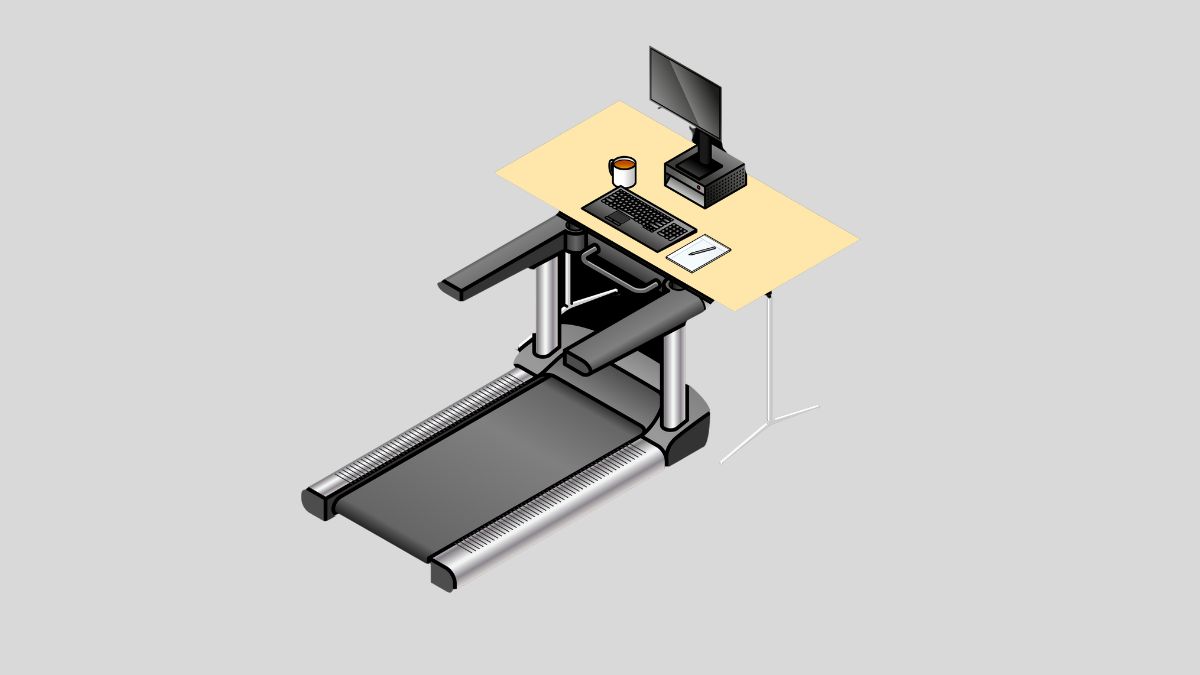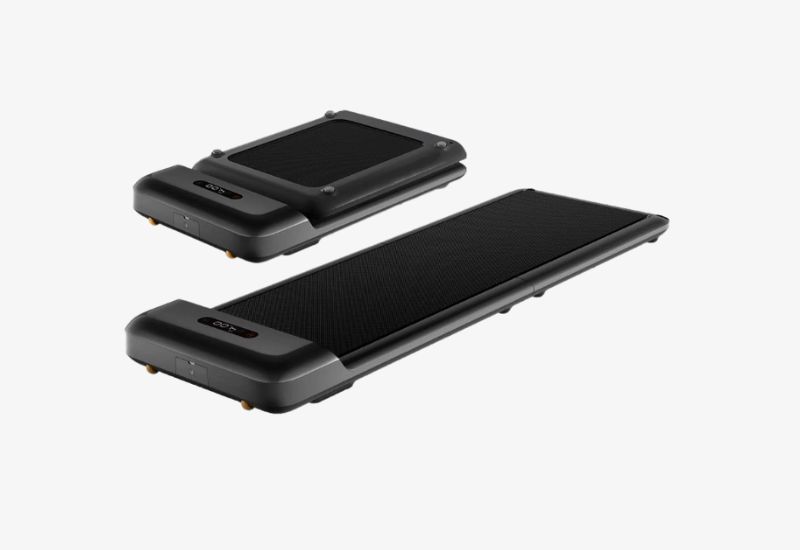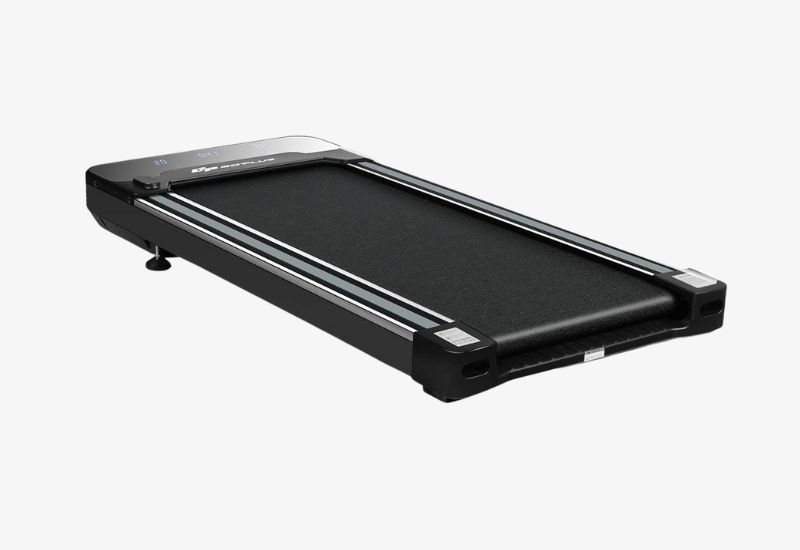Wondering if the hype around under desk treadmills is legit? Here is a look at the pros and cons of this treadmill, and best practices for getting the most from the under desk treadmill.

It’s tough to find ways to exercise over the course of a busy work week.
Between the long hours you spend working, your daily commute, all the chores and to-dos waiting for you at home, and your desire for leisure time, it can sometimes feel like an impossibility to fit in your workout.
I know that when my day is particularly busy, my workout is often the first thing to be sacrificed.
But there’s a solution for us hard-working professionals, a machine that can get us moving even while we’re at the office or working in our home offices.
And that machine is the under desk treadmill!
Below, I’m going to share with you some of the pros and cons of this amazing machine, showing you how it can be useful for helping you get in your workout every day as well as where it’s limitations are.
I’ll also give you tips on how to make the most of your under desk treadmill and use it safely and effectively.
By the end of this post, you’ll agree that this particular treadmill could very well be the thing your very busy days have been missing to get in more activity and better exercise.
Let’s jump in.
Under Desk Treadmills – The Benefits
⭐ Benefit #1: Stand and Move More
This is probably the best thing about the under desk treadmill, and the #1 reason that most people who own one bought it in the first place.
Research has shown that excessive time spent sitting can lead to an early death. Not only do excessively sedentary people burn fewer calories every day, but their muscles weaken, their joints stiffen, and their metabolisms slow down.
Fun Fact: Americans are sitting more than ever before. A study2 from 2016 showed that adults sit an average of 6.4 hours each day, an increase of one hour from the decade prior.
Even their internal organs and brain begin to work less efficiently because their bodies become less capable at sending blood, oxygen, and nutrients where they need to go.
Exercise—even light exercise like walking—can combat that. Spending more time standing and walking on your under desk treadmill will help to counteract the negative effects of sitting.
You don’t need to break a sweat or start sprinting to get the benefits–just the slow, steady pace of walking will do wonders to keep your heart pumping, your blood flowing, and your organs working.
⭐ Benefit #2: Better Brain Health and Function
The benefits of treadmills aren’t limited to just your weight loss or muscular endurance—they also extend to the most important organ in your body: your brain.
Extensive research has shown that even light activity is excellent for your brain, in a number of ways:
- It increases blood flow to the brain.
- It increases electrical activity through the brain and the entire central nervous system.
- It enhances brain plasticity and keeps it from hardening/stiffening.
- It facilitates learning, memory, and recall.
- It helps to sharpen your concentration and focus.
- It activates your innate creativity.
- It can clear your mind of anxious, worried thoughts.
- It elevates your mood.
- It increases the volume of certain critical parts of your brain, such as the frontal lobe and hippocampus.
Really, spending more time walking on the treadmill is one of the smartest things you can do to sharpen your brain.
The fact that you can walk at your desk/at the office means you’ll actually see those brain-boosting effects kick in when you need them most!
⭐ Benefit #3: Better Cardiovascular Health
We all know that exercise is crucial for good cardiovascular health.
Exercise increases your cardiovascular capacity: it strengthens your heart muscles, increases your lungs’ ability to absorb oxygen, and enables your blood vessels to dilate and contract so oxygenated and nutrient-rich blood gets where it needs to go.
But that’s not all!

Exercise also helps to regulate your blood sugar levels, decreasing your risk of Type 2 Diabetes and insulin resistance. Regulating your blood sugar even plays a role in appetite control—you’ll end up eating less because your body is better able to utilize the energy you consume every day.
Exercise will also lower your blood pressure, reducing your risk of hypertension and high blood pressure (both of which are common contributors to more serious cardiovascular conditions).
Even the light exercise of walking on an under desk treadmill will also help to keep your “bad” LDL cholesterol and triglycerides in check, as well as raise levels of your “good” HDL cholesterol. The great thing about this is that raising your HDL cholesterol enables your body to more efficiently regulate LDL cholesterol on its own.
Lower cholesterol levels mean less risk of plaque building up in the arteries, and thus less risk of heart attack, stroke, and peripheral arterial disease.
Put all of these cardiovascular health benefits together, and you’ve got a recipe for a longer, healthier life!
⭐ Benefit #4: More Calories Burned Every Day
It’s amazing just how many calories are burned on the treadmill through your daily jogging or running workouts! Just 30 to 60 minutes per day is a great way to boost your metabolism and enable more effective fat-burning.
But even if you can’t run, you can still walk on the under desk treadmill. You’ll burn fewer calories per hour (as I explain in the “Disadvantages” section) by walking, sure, but there’s something that a lot of people don’t realize.
And that something is: you can often walk for hours without tiring.
Think about the last time you went on a hike or strolled around some new city or town you were visiting on vacation. You probably walked for at least 1-2 hours, maybe even more. I’ve had days where I was so enjoying what I was doing—walking through museums, along beautiful canals, or climbing into the mountains—that I’ve kept on walking for up to 6+ hours in a single day.
Over the course of all that time, your body burns through a lot of calories. The “calories burned per hour” will be lower (maybe 150 to 250, depending on your walking speed and body weight), but by the end of Hour 2 or Hour 3, you’ve burned anywhere from 300 to 750 calories.
Compare that to how many you can burn doing a running workout—up to 330 for a 30-minute training session—and it’s clear to see which is the winner in the short term.
However, a lot of trainees (especially newbies) can’t sustain a full-on run for more than 30 to 60 minutes, but they can walk for hours without tiring.
By hour 5 or 6 of burning 150 to 250 calories per hour, you burn significantly more than you would just by running. Longer time investment, but better results in the end!
⭐ Benefit #5: Fairly Inexpensive
If you compare the cost of treadmill machines, you’ll find that under desk treadmills are among the most inexpensive.
Their price starts in roughly the $250 range, and won’t rise much higher than $600 or $700 for the higher-end models. On the other hand, motorized treadmills will start around $350 and go as high as $2,000.
Under desk treadmills cost less because they tend to be simpler, more compact, and often less sturdy machines.
They’re not designed for running (who wants to run in a suit and tie or a skirt and heels?), so they’re built to withstand less impact. They’re also constructed to take up less space so they can fit under your desk (as their name suggests).
They tend to be smaller, lighter-weight, more portable machines that cost less to build, but also offer fewer features overall.
⭐ Benefit #6: Walk While You Work
I’d argue that this is my favorite reason for considering an under desk treadmill. I love being able to walk while I work—talking on the phone, having Zoom meetings, even while I dictate notes to myself.
It’s a great way to stay active and burn calories, but it can also liven up what might otherwise feel like a boring day.
Plus, I can get in at least a light workout while I’m doing other activities. I will still head out for a proper run or weightlifting session after my work day is over, but while I’m stuck at my desk, I can still move and stand and boost my metabolism.
Under Desk Treadmills – The Disadvantages
Disadvantage #1: Limited Speed Capacity
One of the greatest drawbacks of the under desk treadmill vs running outdoors is that you can never really get up to full run speed.
Under desk treadmills are typically built for a walk—after all, not many people are going to run or sprint in their full business outfits or dress shoes.
Most can reach at least a slow jogging speed (4 to 4.5 MPH), but they’re not typically sturdy enough to withstand a lot of high impact. Really, you’re better off keeping it at a walk for your safety as well as the machine’s longevity.
Disadvantage #2: Limited Calorie-Burning
Don’t get me wrong: there are plenty benefits of walking on the treadmill! It’s amazing cardio, great for burning fat, and an excellent way to improve your posture and agility.
But at the end of the day, walking doesn’t burn anywhere near as many calories as higher-intensity, faster-paced forms of exercise (like running, rowing, stair climbing, lifting weights, etc.). If you have limited amount of time, walking for just 30 to 60 minutes a day on your under desk treadmill won’t really burn enough calories to see real weight loss.

Really, it’s only when you combine both walking on your under desk treadmill and a proper high-intensity workout (be it cardio or resistance training) that you’ll see the real results you want.
Or, as you saw above, you walk for longer—2 to 3 hours, at the very least. That’s when your metabolism really kicks in and you start to burn more energy.
Disadvantage #3: Sweaty and Distracting
Let’s be honest: even with a light walk, a lot of us will still get sweaty. Heavier sweaters will find that over the course of a 30-minute walk, they’ll develop a few pit stains or sweat circles on their chest and back.
Not exactly ideal if you’ve got to look presentable at the office or head out to a meeting, is it? That means you either need to have a change of shirts handy at the office, or accept the sweat marks as a part of life.
And as much fun as walking can be, it can be a bit distracting from work that demands a lot of focus. You may have no problem walking while talking on the phone, but if you’re trying to type data into a spreadsheet or run calculations, the movement can be distracting. (At least, initially, until you grow accustomed to walking while working.)
Plus, it can be an issue for people around you, too. Seeing someone bobbing up and down while on a remote video conference or hearing the whirring of the treadmill motor coming from the office next door is highly distracting.
It’s certainly not a deal-breaker, but it’s a factor you need to take into account when considering how best to use your under desk treadmill at work.
How to Use an Under Desk Treadmill Effectively
✅ Give Yourself Time to Adapt
It’s not easy to make the transition from working sitting down to working standing up, much less working while walking. It’ll take time for your body and brain to get accustomed to the new way of working.
Start off by using the under desk treadmill for just a few minutes every day—say, 20 to 30. Use it for the tasks that require less concentration: talking on the phone, researching on the internet, uploading pictures or videos, etc.
As you grow accustomed to working while walking (or walking while working, depending how you look at it), you can start adding more complex tasks and walk for longer.
Eventually, your body and brain will adapt until it feels a lot more normal. But don’t expect the change to happen overnight!
✅ Beware of Falls
People with poor coordination or balance issues should be very careful when using an under desk treadmill. The last thing you need is for a misstep to cause you to fall and knock your head on your desk, or crash into something behind you.
Steady yourself on your desk if needed, but pay attention to your balance. If you feel yourself wobbling or stumbling, get off the treadmill and give yourself a break.
✅ Beware of Cybersickness
“Cybersickness” is a curious condition that affects people who are moving forward (such as walking or driving) but staring at a non-moving screen (such as tablet, smartphone, or computer screen) for prolonged periods. It’s like motion sickness, but involving your electronic devices.
If you’re new to walking while staring at a monitor, you may find that you start to feel this motion sickness kicking in after a few minutes (or hours) of walking and working. At the first sign of nausea or dizziness, step off the treadmill and stand or sit on solid ground. Only return to staring at your screen once the cybersickness has passed.
Anyone who experiences this regularly may want to avoid walking while staring at a screen.
✅ Don’t Walk All Day
While it’s great to be able to walk for hours at a time, be aware that walking A) can burn through your energy stores and leave you exhausted in the middle of a work day, and B) can grow tiresome as your body maintains the same posture for long periods.
Ideally, you want to alternate between sitting, standing, and walking all day long. Consider switching it up every 30 to 60 minutes, but no less often than every 2 hours.
Moving between these three positions can help you to improve your posture and prevent fatigue.
The Bottom Line
The under desk treadmill can be a game-changing addition to your workstation or home office setup.
The simple fact that you can walk for a few more minutes (or hours) every day means you’ll burn more calories, improve your cardiovascular function, sharpen your brain, boost your mood, and increase your metabolism.
Though there are a few drawbacks (as you saw above), the tips we shared will help you make the most of your brand new mobile working solution!
More Treadmill Guides and Articles
6 Best Treadmills for Heavy People (Bye-Bye Calories). Ready to take your fat-burning and weight loss to the next level? Here is a detailed and hands-on review of the best treadmills for heavy people. No matter what your budget or goal, we’ve got a treadmill for you.
Treadmill Machine vs Outdoor Running – Which is Best for You? Running on a treadmill and running outdoors have a lot of benefits. But they differ in some very key ways. Read on to see the best option for you and your running goals.